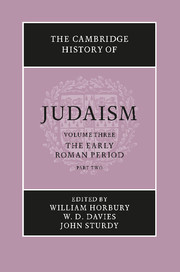Book contents
- Frontmatter
- 1 The archaeology of Palestine 63 bce–ce 70
- 2 The Herodian Temple
- 3 Recent archaeology in Palestine: achievements and future goals
- 4 The contribution of Jewish inscriptions to the study of Judaism
- 5 The social, economic and political history of Palestine 63 bce–ce 70
- 6 The Diaspora in the Roman period before ce 70
- 7 The Gentiles in Judaism 125 bce–ce 66
- 8 Gentiles as seen by Jews after ce 70
- 9 The synagogue
- 10 The Temple and the synagogue
- 11 The early liturgy of the synagogue
- 12 Women in the synagogue
- 13 The Pharisees
- 14 The Sadducees – their history and doctrines
- 15 The Essenes
- 16 The baptist sects
- 17 The troublemakers
- 18 The Samaritans and their sects
- 19 Galilean Judaism and Judaean Judaism
- 20 Jesus: from the Jewish point of view
- 21 Paul: from the Jewish point of view
- 22 Jewish Christianity
- 23 Apocalyptic: the disclosure of heavenly knowledge
- 24 The Qumran sectarian writings
- 25 The Dead Sea Scrolls and pre-Tannaitic Judaism
- 26 Prayer in the Qumran Texts
- 27 Philo of Alexandria
- 28 Josephus (ce 37–c. 100)
- 29 The rabbi in second-century Jewish society
- 30 The Hellenistic–Roman Diaspora ce 70–ce 235: the archaeological evidence
- 31 The legacy of Egypt in Judaism
- 32 Jewish elements in gnosticism and magic c.ce 70–c.ce 270
- Bibliographies
- Index
- References
2 - The Herodian Temple
Published online by Cambridge University Press: 28 March 2008
- Frontmatter
- 1 The archaeology of Palestine 63 bce–ce 70
- 2 The Herodian Temple
- 3 Recent archaeology in Palestine: achievements and future goals
- 4 The contribution of Jewish inscriptions to the study of Judaism
- 5 The social, economic and political history of Palestine 63 bce–ce 70
- 6 The Diaspora in the Roman period before ce 70
- 7 The Gentiles in Judaism 125 bce–ce 66
- 8 Gentiles as seen by Jews after ce 70
- 9 The synagogue
- 10 The Temple and the synagogue
- 11 The early liturgy of the synagogue
- 12 Women in the synagogue
- 13 The Pharisees
- 14 The Sadducees – their history and doctrines
- 15 The Essenes
- 16 The baptist sects
- 17 The troublemakers
- 18 The Samaritans and their sects
- 19 Galilean Judaism and Judaean Judaism
- 20 Jesus: from the Jewish point of view
- 21 Paul: from the Jewish point of view
- 22 Jewish Christianity
- 23 Apocalyptic: the disclosure of heavenly knowledge
- 24 The Qumran sectarian writings
- 25 The Dead Sea Scrolls and pre-Tannaitic Judaism
- 26 Prayer in the Qumran Texts
- 27 Philo of Alexandria
- 28 Josephus (ce 37–c. 100)
- 29 The rabbi in second-century Jewish society
- 30 The Hellenistic–Roman Diaspora ce 70–ce 235: the archaeological evidence
- 31 The legacy of Egypt in Judaism
- 32 Jewish elements in gnosticism and magic c.ce 70–c.ce 270
- Bibliographies
- Index
- References
Summary
THE SOURCES
Any attempt at a theoretical reconstruction of Herod's Temple must be based on the available literary sources as well as the evidence produced by archaeology. The two main literary sources which we have are Flavius Josephus' descriptions of the Temple as given in Ant.xv.380–425 and Bell.v.184–227 as well as several additional references to its history given by Josephus and, secondly, the various descriptions recorded in the Mishnah, especially that given in m. Mid. which contains a general description of the Temple and m. Tamid,i:1–3. In addition, several New Testament passages mention the beauty of Herod's building (Mark 13:1; Luke 21:5), while ‘Solomon's Portico’ is mentioned in John 10:23.
Research in the vicinity of the Temple itself, especially the work of the last hundred years, has been limited to the outer walls of the Temple Mount. Owing to the existence of Muslim shrines on the Mount, no excavations were ever carried out there. Sir Charles Warren pioneered scientific investigation of the Temple area, and his publication, describing work carried out during the years 1867–70, is still considered a prime source, a ‘text-book’ on the subject. More recent studies, however, have added to Warren's architectural discoveries and have yielded many new finds which help us to gain a clearer conception of daily life in the Temple.
THE HISTORY OF THE TEMPLE
The building of the Temple began either in Herod's eighteenth regnal year (Ant. xv. 380ff) or in the fifteenth (Bell. i.401), with the former date seemingly the more probable, that is, 20/19 bce. The work continued for nine and a half years (Ant. xv.420 –1), with the construction of the outer walls and porticoes taking eight years and the building of the Temple itself a year and a half.
- Type
- Chapter
- Information
- The Cambridge History of Judaism , pp. 38 - 58Publisher: Cambridge University PressPrint publication year: 1999
References
- 5
- Cited by

